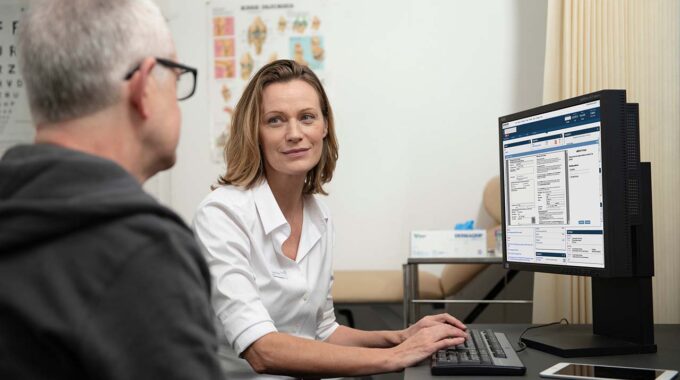Northampton General Hospital NHS Trust (NGH) has signed a ten-year contract with Nervecentre to implement…
Maternity in focus: Promoting safe prescribing practice
Blog by Emma Price, Maternity Product Specialist
 As a Maternity Product Specialist at Nervecentre Software, part of my role is to focus on the development and progress of healthcare technology within maternity across NHS trusts. Safety is imperative within the maternity landscape, and through observing best practice, it became clear that our mobile Electronic Prescribing and Medicines Administration (EPMA) system has been utilised to support clinical practice, improve efficiency, and optimise patient safety. Features such as closed loop administration using mobile barcode scanning at the point of administration, interaction with real time vital signs and pathology data to ensure safe medication delivery, links to national guidelines and automated decision support with alerts and notifications to pharmacies, all encourage appropriate prescribing and administration.
As a Maternity Product Specialist at Nervecentre Software, part of my role is to focus on the development and progress of healthcare technology within maternity across NHS trusts. Safety is imperative within the maternity landscape, and through observing best practice, it became clear that our mobile Electronic Prescribing and Medicines Administration (EPMA) system has been utilised to support clinical practice, improve efficiency, and optimise patient safety. Features such as closed loop administration using mobile barcode scanning at the point of administration, interaction with real time vital signs and pathology data to ensure safe medication delivery, links to national guidelines and automated decision support with alerts and notifications to pharmacies, all encourage appropriate prescribing and administration.
At Nervecentre, we promote a collaborative working partnership with all our customers to optimise our software solutions. We have been working with University Hospitals of Leicester NHS Trust (UHL) to replace their previous EPMA with a next-generation Nervecentre EPMA system. Their requirement was for a new solution that could deal with the configuration of complex regimens with enhanced clinical decision support, including complex regimens and variable rate infusions. The EPMA system roll out occurred amid the pandemic across 3 sites, with 1745 patient drug charts transcribed over 4 days, recording over 5,200,000 drug administration events during the go live. Some of the highlights of the work completed at the trust to improve operational effectiveness and patient safety include:
- Medicines configuration
The EPMA system has over 3000 dose sentences and order sets configured. These save prescribers time, provide standardisation and enhance patient safety.
To demonstrate the flexibility of the system, UHL were able to configure ultra-complex regimens such as haemodialysis prescriptions within the drug chart
- Smart lists –medicines orders
Smart lists have been configured to facilitate the collation of ‘real time’ information for action, e.g. orders of medicines for processing. This has resulted in greater visibility and speeded up response times by at least 70% in comparison to their previous EPMA system
- E-observations and insulin
E-observations results can be displayed within dose sentences. This allowed UHL to display blood glucose and ketone levels alongside the insulin dose sentences. As prescribers and nurses could see this information, it was decided to move all dosing of subcutaneous insulin from paper insulin charts onto Nervecentre, thus reducing paperwork significantly!
Usability is a key factor in a successful EPMA system, and as we looked at the prescribing data captured following the launch of the system at UHL, it became apparent that maternity clinicians were prescribing disproportionately high volumes of order set prescriptions (sets of medications configured to be prescribed in one step) across the trust, with the mobile app being the preferred interface to prescribe and administer on. In October 2022, nearly 10,000 drug prescriptions were made using maternity order sets on the mobile, with nearly 90% of all maternity prescriptions being ordered on a mobile device. Following conversations with UHL clinicians and by looking at data trends, the high levels of engagement and mobile use within maternity are being driven by several themes.
Logical Maternity Order Sets
The patient cohort of pregnant women has a low background burden of disease with regularly prescribed sets of medication which facilitates the configuration of order sets. Furthermore, the use of updated and streamlined maternity guidelines and protocols by senior obstetricians and anaesthetists, underpinned the configuration of a wide depth and breadth of logical and relevant order sets including induction of labour, epidurals, chorioamnionitis and common postnatal medication. Due diligence was exercised at the outset to ensure the maternity EPMA configuration was fit for purpose. Additional collaboration between UHL and Nervecentre to tweak and update order sets once in clinical practice, has ensured that the prescriptions remain clinically relevant and reflect changes to practice..
Nichola Ling, Consultant Obstetrician at UHL, who was pivotal in the configuration of the maternity order sets, suggested that the high levels of usage is due to a unique approach. Firstly, the patient was placed at the centre of the care given, where clinicians that frequently prescribed maternity medications, identified the most common patient presentations. Crucially, rather than organising the order sets in commonly recognised groups of medication, the order sets were configured to contain a range of medication to satisfy the common patient presentations. Furthermore, supporting clinical notes suggested first, second and third line options to guide prescribers. I am delighted at the success of the maternity order sets she added.
Mobile promoting usability
Mobile and tablet use on maternity wards and theatres is disproportionately high due to the environment. Restricted space in theatres and the clinician’s desire to provide care to mothers at their bedside also promotes mobile and tablet usage. The Nervecentre app provides a logical layout for all clinicians to carry out clinical activities at the patient’s bedside, enhancing the rapport between the clinician and patient. In addition, integrating the EPMA functionality within the Nervecentre app so everything is together in one place, provides a basis for users to prescribe and administer medicines irrespective of location and hardware available.
One of the Consultant Anaesthetists at UHL explained “because the order sets are laid out so logically on the Nervecentre app, this is the most efficient way to prescribe by a long way”
It is really rewarding to see the positive influence a fully optimised EPMA system operating within a maternity context can make to the clinicians. This is a great example of senior clinicians from UHL, engaging with Nervecentre to contribute to the development process, thus promoting ease of use and enhanced capabilities including the broad range of order sets and barcode scanning from mobile devices. This is all still applicable when used in conjunction with third party maternity systems too.
I would be happy to collaborate with other trusts and facilitate the promotion of sharing best practice within the EPMA maternity setting. If this is of interest, then please feel free to get in touch with me via email [email protected].




This Post Has 0 Comments